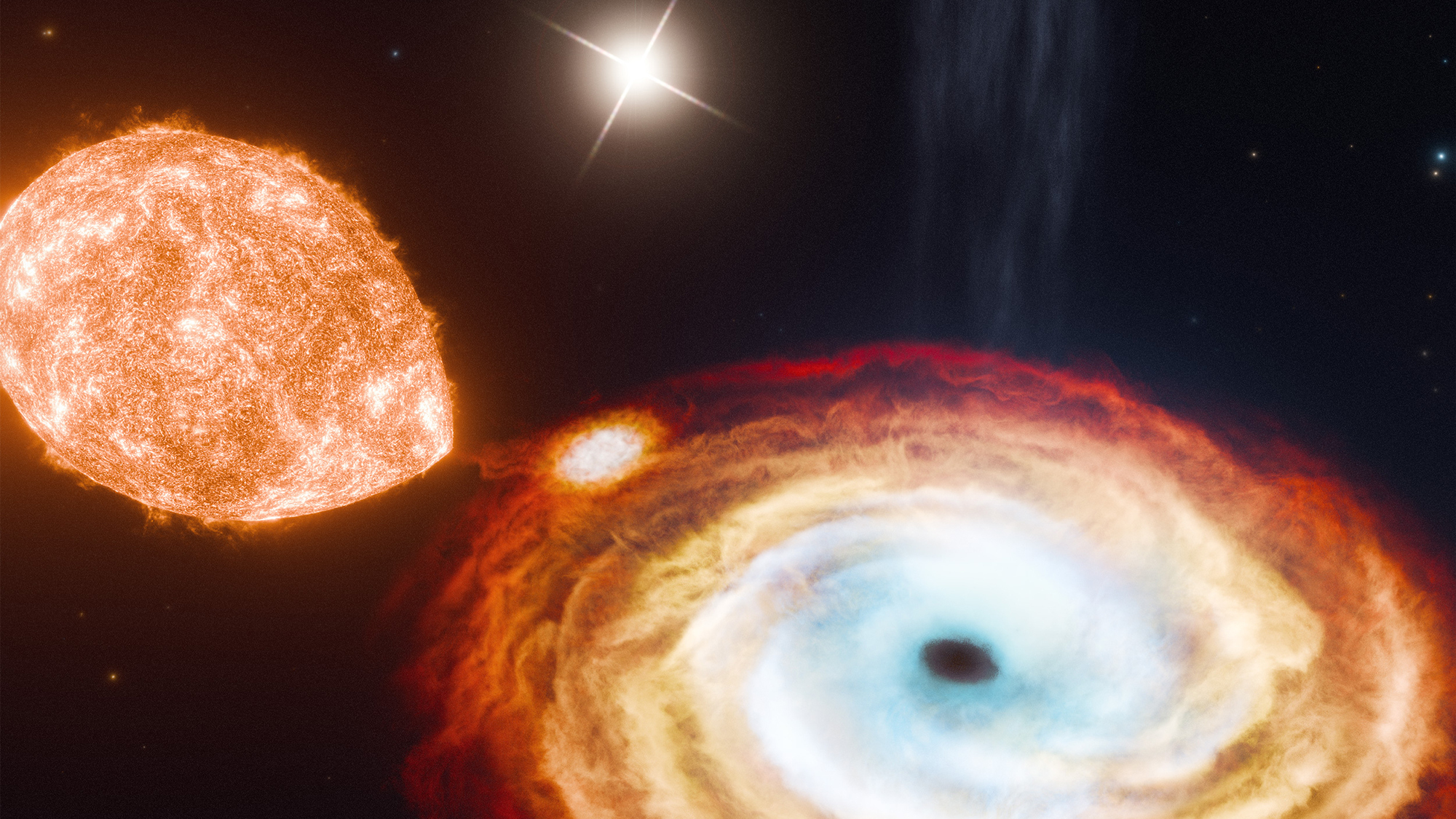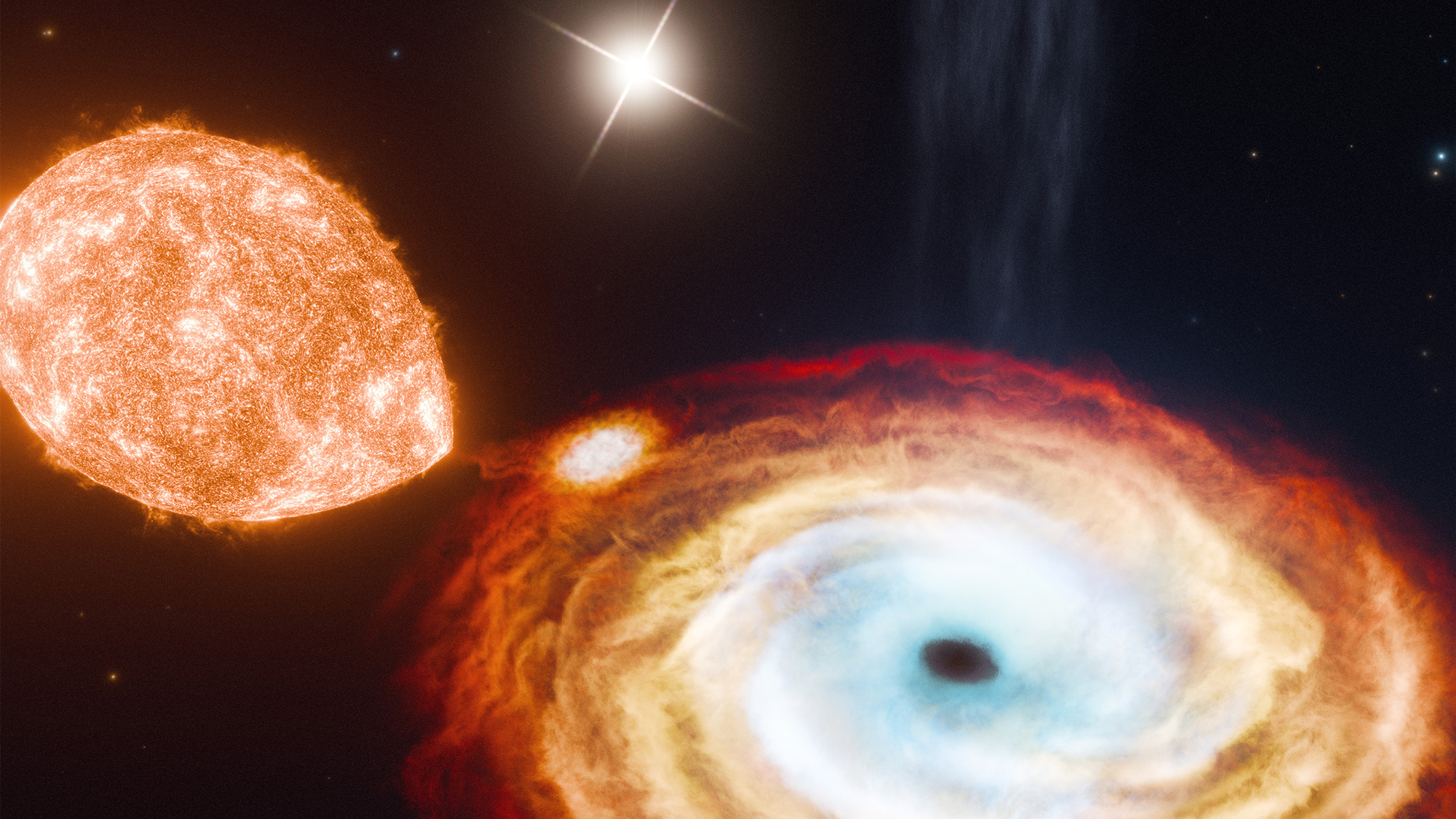
For the first time, physicists have observed a “black hole triple” in space. This new system is about 8,000 light years away from Earth and is made up of a central black hole that is in the act of consuming a small star spiraling very close to it. Surprisingly, a second star appears to also be circling the central black hole, but much further away. The discovery is described in a study published October 23 in the journal Nature.
Hitting a triple
Most of the black holes that scientists have detected appear to be part of a pair called a binary system. These systems are made up of the black hole and a secondary object like a star, much denser neutron star, or another black hole. The binary system then spirals around each other and are drawn together by the black hole’s gravity.
For this new black hole triple, there is an additional object orbiting the central black hole. The closer star orbits the black hole about every 6.5 days. The authors estimate that the more far-off companion orbits the black hole every 70,000 years.
[Related: The hunt for the first stars in the universe.]
That a black hole appears to have a gravitational hold on an object that is so far away is raising some questions about the origins of this black hole itself. Scientists believe that black holes form from a supernova–the violent explosion of a dying star. During a supernova, a star releases a huge amount of energy and light in one final burst before it collapses into an invisible black hole.
If this newly-observed black hole resulted from a typical supernova, the energy it would have released before it ultimately collapsed would have kicked away any more loosely bound objects orbiting on its outskirts. In theory, that second outer star shouldn’t still be hanging around.
The team believes that the black hole formed through a more gentle process instead–direct collapse. During direct collapse, a star simply caves in on itself and forms a black hole without that last dramatic burst. A gentle origin like this wouldn’t really disturb any loosely bound, faraway objects.
Since the new triple system includes a very far-off star, the system’s black hole was potentially born through that gentler direct collapse. While astronomers have been observing violent supernovae for centuries, this new triple system may be the first evidence of a black hole that formed from this more gentle process.
“We think most black holes form from violent explosions of stars, but this discovery helps call that into question,” study co-author and MIT physicist Kevin Burdge said in a statement. “This system is super exciting for black hole evolution, and it also raises questions of whether there are more triples out there.”
Chance discovery
This discovery also came about almost by chance. The physicists found it while looking through a repository of astronomical observations taken by telescopes in space and around the world called Aladin Lite. They used Aladin Lite to search for images of the same part of the sky, taken by different telescopes tuned to various wavelengths of energy and light.
Originally, they were looking within the Milky Way galaxy for signs of new black holes. Out of curiosity, Burdge reviewed an image of V404 Cygni, a black hole roughly 8,000 light years from Earth. In 1992, V404 Cygni became one of the very first objects in space to be confirmed as a black. Since then, it has been documented in over 1,300 scientific papers and is one of our most well-studied black holes. However, none of these studies reported this strange triple system.
[Related: 1.5 billion cosmic objects dazzle in the largest infrared Milky Way map ever created.]
While looking at optical images of V404 Cygni, Burdge saw what looked like two blobs of light that were close to one another. The first blob was the black hole and an inner star orbiting close by. That star is so close to the hole that it is releasing some of its material onto the black hole itself and giving off visible light. However, that second blob of light was most likely coming from a very distant star that had not been observed before.
“The fact that we can see two separate stars over this much distance actually means that the stars have to be really very far apart,” said Burdge.
Calculations found that the outer star is 3,500 astronomical units (AU) away from the black hole. One AU is the distance between Earth and the sun. The outer star is thus 3,500 times further away from the black hole as we are to the sun, or 100 times greater than the distance between Pluto and the sun.
The team then questioned whether the outer star was linked to both the black hole and its inner star. To find an answer, the team looked to Gaia, the satellite that has been tracking the motions of all the stars in the galaxy for a decade. They analyzed the motions of the inner and outer stars over the past 10 years of Gaia data and found that the stars moved in tandem compared to some of the nearby stars. According to their calculations, the odds of this kind of tandem motion are about one in 10 million.
“It’s almost certainly not a coincidence or accident,” Burdge said. “We’re seeing two stars that are following each other because they’re attached by this weak string of gravity. So this has to be a triple system.”
Let’s go fly a (space) kite
The team then wondered how this system could have formed in the first place. The violent explosion of a typical supernova would have kicked that outstar away a very long time ago.
“Imagine you’re pulling a kite, and instead of a strong string, you’re pulling with a spider web,” Burdge said. “If you tugged too hard, the web would break and you’d lose the kite. Gravity is like this barely bound string that’s really weak, and if you do anything dramatic to the inner binary, you’re going to lose the outer star.”
To test out this kite string theory, Burdge carried out computer simulations to see how this kind of triple system could have evolved and kept the outer star.
[Related: Biggest black hole jets ever seen span 140 Milky Way galaxies.]
At the beginning of each simulation, he introduced three stars. The third star was the black hole, before it became a black hole. He then ran tens of thousands of simulations. Each simulation had a slightly different scenario for how the third star may have become a black hole and affected the motions of the other two stars. For example, he simulated a supernova and changed the amount of energy and the direction all of that energy traveled in. He also simulated scenarios of direct collapse, where the third star caved in on itself to form a black hole, without sending off any energy.
“The vast majority of simulations show that the easiest way to make this triple work is through direct collapse,” Burdge says.
This extra outer star also revealed the system’s age. The team observed that the outer star is in the process of becoming a red giant, a phase occurring at the end of a star’s life. They believe that the outerstar is about 4 billion years old, based on this transition. Since the neighboring stars are born around the same time, the team believes that this black hole triple is also 4 billion years old.
“We’ve never been able to do this before for an old black hole,” Burdge said. “Now we know V404 Cygni is part of a triple, it could have formed from direct collapse, and it formed about 4 billion years ago, thanks to this discovery.”

